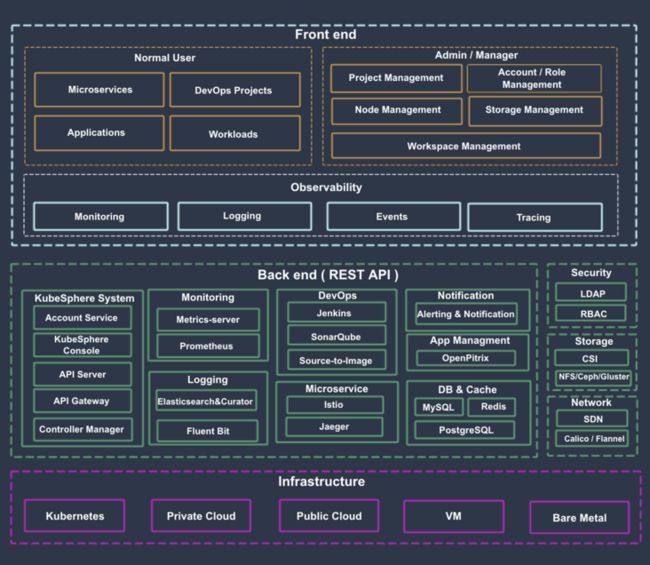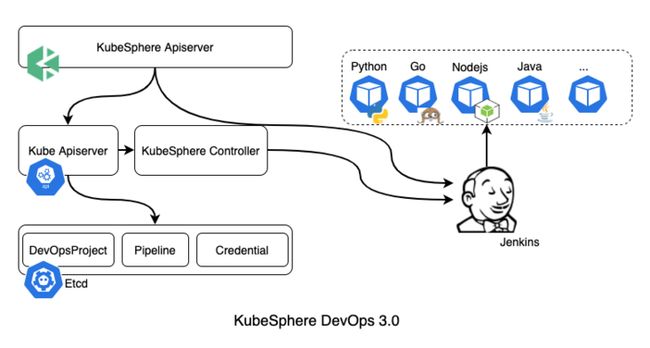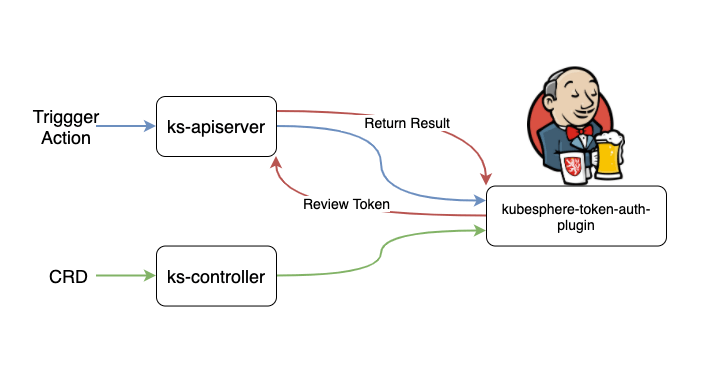作者:gfengwong
原文链接
KubeSphere 的 DevOps 模块介绍
- KubeSphere 使用可插拔的 DevOps 模块实现 DevOps 功能;
- DevOps 驱动 Jenkins 实现具体的操作,例如流水线等。
DevOps 与 KubeSphere 的关系如下图, 详细的组件介绍。
集成的亮点
DevOps 与 Jenkins 集成紧密且优雅,从构建、部署到使用维护纯云原生方式实现:
- 一键部署;
- 一个参数启用 DevOps 功能;
- 一个 K8s 集群内即可完成从 Jenkins、流水线的全生命周期。
具体集成说明
用户使用 KubeSphere 平台的 DevOps 功能时,调用 devops-api 发送请求,DevOps 收到请求后,部分请求直接调用 jenkins 进行操作,部分请求通过更新 devops-controller 监听的资源,通过 devops-controller 来操作 Jenkins。
运行流水线阶段,Jenkins 配置了 K8s 动态 slave:
- Jenkins pod 信息(镜像、卷等)发送给 K8s;
- K8s 启动 Jenkins slave pod 并通过远程协议与 Jenkins master 建立连接;
- 运行流水线;
- 运行完毕之后根据设置删除/保留创建的 pod。
Jenkins 镜像构建
Jenkins 本身是一个 Java 应用,当前也没有提供官方的云原生方案,KubeSphere 通过下面几个项目定制了自己的镜像:
- custom-war-packager 定制自己的 Jenkins 并生成 Docker 镜像或者 war 镜像;
- formulas 通过 formula.yaml 定制自己的 Jenkins,针对中国区优化;
- ks-jenkins 定制了 KubeSphere 自己的 Jenkins 镜像 使用了 jcli 集成了 cwp。
ks-devops 项目中的 formulas 安装了所有需要的 Jenkins 插件主要有
- Blue Ocean 提供了 Jenkins 的 restful API;
- kubernetes 提供了动态 slave 能力;
- kubesphere-token-auth 集成 KubeSphere 权限体系;
- 其他。
Jenkins 与 DevOps 的部署
ks-installer(Ansible) 生成环境变量,主要有:
- 要不要使用 ksauth;
- 生成 ksauth 使用的密码;
- 主要环境变量在 https://github.com/kubesphere... ;
- helm 部署 DevOps 和 Jenkins helm 项目。
ks-devops-helm-chart:
这个项目里面主要有三个 chart。
- DevOps
部署 devops-apiserver 和 devops-controller。
注意 ⚠️ 这里有一个 cronjob 作用为清理执行过的流水线记录,定期执行 ks pip gc。
主要部署的资源有:
deployment
- devops-apiserver
- devops-controller
cronjob
- devops
configmap
- devops-config
- jenkins-agent-config
- Jenkins
Jenkins 配置:
- Maven 配置
charts/ks-devops/charts/jenkins/templates/jenkins-agent-config.yaml 配置 Jenkins dynamic slave
charts/ks-devops/charts/jenkins/templates/jenkins-casc-config.yml- 自动化配置 Jenkins Configure Clouds
- 配置 K8s 认证
- 配置 pod volume image lable 等
- 会将上面的 Maven 配置挂在到 Maven 容器中
- 将 Maven 配置和 casc 配置以 configmap 的方式挂在到 Jenkins 容器的
/var/jenkins_home/casc_configs, 从 helm 的 value 获取 value.yaml
charts/ks-devops/charts/jenkins/values.yaml中定义了:- 环境变量 从 value 读出配置到容器中,设置了登陆用的用户名密码
初始化脚本 -- 在 helm 渲染 Jenkins deploy 时挂载到 configmap 中
- mariler 插件 -- 绑定邮箱
- K8s 插件 -- 创建 K8s credential
- RBAC 配置
Jenkins pod 初始化:
K8s 插件配置
charts/ks-devops/charts/jenkins/templates/config.yamlconfig.xml
- 创建 role
kubesphere-user所有资源只读并绑定到authenticated用户 - ladp 配置,对接 kubesphere ladp
- cloud 配置:pod template container 配置、挂载等等,包括 Maven 配置、Docker sock 等
- 创建 role
apply_config.sh jenkins 工作目录初始化
slave-to-master-security-kill-switch禁用 agent 访问控制机制- 拷贝 config.xml 到容器
/var/jenkins_home 将用于初始化的 groovy 文件拷贝到
/var/jenkins_home/init.groovy.d- 初始化用于 cloud 的 credential
Kubernetes service account - Mailer 模块初始化
- RBAC 初始化:创建 admin 和 kubesphere-user 对应的 role 做绑定
- Sonarqube 初始化
- 用户初始化,创建 admin 用户并设置密码
- 初始化用于 cloud 的 credential
deployment
charts/ks-devops/charts/jenkins/templates/jenkins-master-deployment.yaml设置环境变量
- jvm 参数
- admin 用户名密码
- 超时配置
- 邮箱配置
- limit 注意:默认 memory 为 2g,一般是不够用的,跑多个任务就会引起 pod crash,所以至少设置成 4g
- initContainer 运行
/var/jenkins_config/apply_config.sh初始化 jenkins 配置,如安装插件、配置 cloud、rbac 等等
到这里 Jenkins pod 就创建出来了,我们可以直接开始使用 Jenkins 运行流水线了。
Jenkins K8s 动态 slave
KubeSphere 内置 Jenkins
配置:
KubeSphere 通过 ks-install 和 helm 都配置好了,无需单独配置。
使用:
以流水线为例,groovy 中添加以下字段会按照 'base' 去匹配 pod 的 lable,匹配到了会使用这个 label 的 pod 模板启动 pod 运行流水线,下面有两个 pipeline 脚本,第一个是选定了 pod 的模板的会启动一个 pod 来执行,第二个 any,如果设置了 master 节点为 Only build jobs with label expressions matching this node 将会启动 base pod 来运行,如果选择 Use this node as much as possible 则会在 Jenkins 自身的容器/服务器上运行,如果是普通 job 的话,勾选Restrict where this project can be run 且填写 Label Expression 选择要运行的 label,和 pipeline 类似。
pipeline {
agent {
node {
label 'base'
}
}
stages {
stage('Run shell') {
steps {
sh 'echo hello world'
}
}
}
}pipeline {
agent any
stages {
stage('Run shell') {
steps {
sh 'echo hello world'
}
}
}
}独立部署的 Jenkins
cloud 配置 K8s:
Manage Node → Configure Clouds。
- K8s;
- K8s URL:K8s apiserver 地址, 与 KubeSphere 自带的 Jenkins 不同的是使用了集群内部链接;
- K8s Namespace:slave pod 运行的 namespace;
- Credentials:使用 secret file,上传 kubeconfig 与 KubeSphere 自带的 Jenkins 不同的是使用了
kubernetes service account; - 使用 WebSocket 通信 -- 使用 Jenkins tunnel 通信;
- Jenkins URL:Jenkins API 地址;
- 其他:其他的 pod 配置按需配置即可,这里和 KubeSphere 的一样。
Q & A
使用 Maven 构建时,Maven 仓库如何配置?
pod 所使用的 Maven 配置是挂载进去的,可以通过 Jenkins->Configuration->Maven Project Configuration 配置
KubeSphere → Jenkins → K8s,认证是如何实现的?
KubeSphere 与 Jenkins 的认证:
Jenkins 插件 kubesphere-token-auth-plugin 集成 KubeSphere 的认证体系,在 KubeSphere 调用 Jenkins 时,都需要经过 ks-apiserver 进行 token 的 review, 通过之后再调用 Jenkins 执行实际动作
Jenkins 使用驱动 K8s 实现动态 slave:
- Jenkins 的 deployment 中声明了
serviceAccountNamedevops-jenkins; - 启动的 pod 会将对应 serviceAccount 的 token 写入 pod 文件系统中
/var/run/secrets/kubernetes.io/serviceaccount/token; - Jenkins K8s 插件会去读 pod 文件系统的 token,这样就可以通过 token 来调度 K8s 资源实现 slave pod 的创建删除。
如果是外置 Jenkins 则无法通过读取 token 来连接 K8s,需要手动创建 serviceAccount、clusterRole、clusterRoleBinding,然后将 token 以 Secret text 或者将 ca 证书以 Secret file 形式或将 kubconfig 以 Secret file 形式写入 credentials。
部署使用问题
误删 apiserivice
kubectl delete --all apiservice解决方式
参照:https://github.com/kubernetes...
将 kube-apiserver.yaml 移到其他文件夹,这时 kube-apiserver 的 pod 会 down 掉。
mv /etc/kubernetes/manifests/kube-apiserver.yaml /etc/kubernetes/在其他 API 正常的节点删除这个 pod,再将配置文件移回去,即可恢复。
KubeSphere API 服务无法启动
版本:KubeSphere v3.3.0。
错误描述
install failed, ks-controller CrashLoopBackOff
E1116 00:55:15.113761 1 notification_controller.go:113] get /, Kind= informer error, no matches for kind "Config" in version "notification.kubesphere.io/v2beta1"
F1116 00:55:15.113806 1 server.go:340] unable to register controllers to the manager: no matches for kind "Config" in version "notification.kubesphere.io/v2beta1"解决方式
kubectl apply -f https://raw.githubusercontent.com/kubesphere/notification-manager/master/config/bundle.yamlJNLP 容器无法启动
JNLP 是 Jenkin 的远程调用协议。
[root@k8s-1 ~]# kubectl logs -f -n kubesphere-devops-worker base-w9dpq jnlp
Warning: SECRET is defined twice in command-line arguments and the environment variable
Warning: AGENT_NAME is defined twice in command-line arguments and the environment variable
Sep 14, 2022 11:29:43 AM hudson.remoting.jnlp.Main createEngine
INFO: Setting up agent: base-w9dpq
Sep 14, 2022 11:29:44 AM hudson.remoting.jnlp.Main$CuiListener
INFO: Jenkins agent is running in headless mode.
Sep 14, 2022 11:29:44 AM hudson.remoting.Engine startEngine
INFO: Using Remoting version: 4.10
Sep 14, 2022 11:29:44 AM org.jenkinsci.remoting.engine.WorkDirManager initializeWorkDir
INFO: Using /home/jenkins/agent/remoting as a remoting work directory
Sep 14, 2022 11:29:44 AM org.jenkinsci.remoting.engine.WorkDirManager setupLogging
INFO: Both error and output logs will be printed to /home/jenkins/agent/remoting
Sep 14, 2022 11:29:44 AM hudson.remoting.jnlp.Main$CuiListener status
INFO: Locating server among [http://172.16.80.38:8080/]
Sep 14, 2022 11:29:44 AM hudson.remoting.jnlp.Main$CuiListener error
SEVERE: http://172.16.80.38:8080/tcpSlaveAgentListener/ is invalid: 404 Not Found
java.io.IOException: http://172.16.80.38:8080/tcpSlaveAgentListener/ is invalid: 404 Not Found
at org.jenkinsci.remoting.engine.JnlpAgentEndpointResolver.resolve(JnlpAgentEndpointResolver.java:219)
at hudson.remoting.Engine.innerRun(Engine.java:724)
at hudson.remoting.Engine.run(Engine.java:540) Sep 14, 2022 11:33:41 AM hudson.remoting.jnlp.Main$CuiListener status
INFO: Locating server among [http://devops-jenkins.kubesphere-devops-system:80/]
Sep 14, 2022 11:33:42 AM org.jenkinsci.remoting.engine.JnlpAgentEndpointResolver resolve
INFO: Remoting server accepts the following protocols: [JNLP4-connect, Ping]
Sep 14, 2022 11:33:42 AM org.jenkinsci.remoting.engine.JnlpAgentEndpointResolver resolve
INFO: Remoting TCP connection tunneling is enabled. Skipping the TCP Agent Listener Port availability check
Sep 14, 2022 11:33:42 AM hudson.remoting.jnlp.Main$CuiListener status
INFO: Agent discovery successful
Agent address: devops-jenkins-agent.kubesphere-devops-system
Agent port: 50000
Identity: 13:ea:2b:ab:b5:16:70:70:89:58:d1:66:2b:62:b1:16
Sep 14, 2022 11:33:42 AM hudson.remoting.jnlp.Main$CuiListener status
INFO: Handshaking
Sep 14, 2022 11:33:42 AM hudson.remoting.jnlp.Main$CuiListener status
INFO: Connecting to devops-jenkins-agent.kubesphere-devops-system:50000
Sep 14, 2022 11:33:42 AM hudson.remoting.jnlp.Main$CuiListener status
INFO: Trying protocol: JNLP4-connect
Sep 14, 2022 11:33:42 AM org.jenkinsci.remoting.protocol.impl.BIONetworkLayer$Reader run
INFO: Waiting for ProtocolStack to start.
Sep 14, 2022 11:33:46 AM hudson.remoting.jnlp.Main$CuiListener status
INFO: Remote identity confirmed: 13:ea:2b:ab:b5:16:70:70:89:58:d1:66:2b:62:b1:16
Sep 14, 2022 11:33:46 AM hudson.remoting.jnlp.Main$CuiListener status
INFO: Connected
Sep 14, 2022 11:33:58 AM org.csanchez.jenkins.plugins.kubernetes.KubernetesSlave$SlaveDisconnector call
INFO: Disabled agent engine reconnects.附录:认证备忘
ks-installer/roles/ks-core/init-token/tasks/main.yaml生成一个随机值 secret;- 部署 KubeSphere 的时候初始化通过
ks-installer/roles/ks-core/init-token/files/jwt-script/jwt.sh生成了一个 jwt token 入参为上面生成的字符串和 '{"email": "[email protected]","username": "admin","token_type": "static_token"}'; - 通过生成的 token 和 secret 创建 secret 名为 kubesphere-secret;
- 部署 DevOps 的时候将填入
authentication.jwtSecret devops.password通过 helm 部署 DevOps; - 部署 Jenkin 的密码为写死的"P@ssw0rd";
- admin password 生成了一个随机的 22 位字符串写入 Jenkins pod 环境变了并通过读取 configmap devops-jenkins 启动 Jenkins。
参考资料
- jcli
- jcli 使用手册
- custom-war-packager
- Jenkins Kubernetes 插件
- KubeSphere DevOps 3.0 流水线开发指南
- Jenkins 基于 Kubernetes 动态创建 pod
- Can I use Jenkins kubernetes plugin when Jenkins server is outside of a kubernetes cluster?
- kubernetes-jenkins-integration
本文由博客一文多发平台 OpenWrite 发布!


